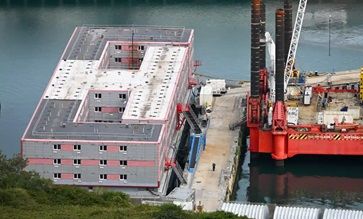Safety inspectors have demanded five urgent alterations to the Bibby Stockholm, the giant barge meant to hold hundreds of people seeking asylum, because of risks to their lives in the event of fire, documents released under the Freedom of Information Act show. Dorset and Wiltshire fire service examined the vessel in Portland, Dorset, after the first asylum seekers were taken on board three weeks ago.
Officials concluded in their fire inspection report, released under FoI, that lives could be put at risk because there were too few fire escapes, a lack of fire drills, and problems with air vents that would have to be rectified within weeks. Home Office sources did not confirm whether the changes outlined in the report would be made.
Tim Naor Hilton, chief executive of Refugee Action, which obtained the report, said: “No one should be forced to live cheek by jowl on what is effectively a prison ship – even if it was 100% fire safe. But it’s appalling that ministers were happy to put people’s safety at risk and move them on to a boat that had insufficient fire escapes, problems with air vents and no strategy to conduct drills.
“The Bibby Stockholm has become a floating statue of the government’s failed strategy of cruelty. This plan must be scrapped and people housed with dignity in our communities.”
The Home Office this August denied firefighters’ claims that the vessel was a potential deathtrap. The Guardian disclosed that hundreds of people could be moved on to the Bibby Stockholm despite an inspection finding plumbing problems that could take months to repair.
In the fire service’s report, which was sent to the barge’s contractors, Landry and Kling, on 10 August and copied to the Home Office, inspectors said five changes had to be implemented within a month. “The audit identified that some people were at risk in case of fire, and improvements are required to provide additional safety. The improvements should be completed within 1 months [sic] of this letter.”
The changes include reinstating an alternative escape route from the stern of the barge leading from the canteen. “The provision of exits from the canteen/dining room is inadequate for the number of people who may be required to use them. This means that people may not be able to escape safely in case of fire,” the inspector wrote.
The contractor was told to install easy to open door securing mechanisms for 10 bedrooms, saying that “people requiring to use these doors in an emergency may not be able to open them easily, preventing them from escaping safely”.
Vents that could be manually opened by fire crews had to be built into two main escape routes on the barge, the report said. “Protected stairways require a means to ventilate any residual smoke that may enter the stairway during evacuation or firefighting operations,” it said.
A fire resistant wall had to be reinstated, the report said, because otherwise “fire and smoke could spread rapidly from the store which could enter the escape routes and make them unsafe for people to use, exposing them to harm”. And regular fire drills had to be held, day and night. “If people do not understand what to do in case of fire they may behave inappropriately if fire breaks out,” the report said.








